Review: Is the Smith & Wesson SW910TA knife a boom or a bust?
The Smith #TheSmith

Modern knives come in all shapes and sizes and with a dazzling array of colors, finishes, and blade steels. Many of the knives I bought as a kid fell into the category of cool-looking pocket clutter. Those knives looked great, like the Victorinox knock-off I snagged at a tourist trap in Estes Park, Colorado. It had “ivory” scales with sweet printing on either side of a mountain lion, the biggest, baddest cat in my neck of the woods. It couldn’t hold an edge worth spit, but man, did it look good. I carried it everywhere, but once the blade dulled, it was forced into retirement. (I hadn’t learned how to sharpen my blades yet.)
Sometimes, choosing a knife to buy goes only skin deep, but sometimes looks can be deceiving. Despite its solid reputation as a firearms manufacturer, Smith & Wesson’s blades tend to get knocked quite a bit in the knife world, especially among those who spend their time stroking their Spydercos and caressing their CRKTs. As someone who has heard the rumors but never used a Smith & Wesson knife, I decided to check out the company’s SW910TA. I regularly carry a small, skeletonized SOG Instinct that makes me feel good about carrying a fixed blade, but in reality, my SOG probably wouldn’t do me much good defensively compared to a larger knife. The Smith & Wesson looked like a knife with a better blade for keeping threats at bay. It was also both lightweight-looking and came with its own sheath.
When I requested the Smith & Wesson SW910TA, I could only wait and wonder whether or not this knife would live up to the rumors or turn out to be a diamond in the rough. Here’s what I discovered.
Blade length: 3.4 in
Weight: 7.05 oz
Material: 7Cr17MoV high carbon stainless steel
Unboxing
They say you shouldn’t judge a book by its cover, but honestly, first impressions matter to people. When it comes to knives, Smith & Wesson is a budget brand, quite different from their reputation in the firearms industry, and it shows in the packaging of this blade. The SW910TA comes in a navy cardboard box and a matching lid with the Smith & Wesson logo and the phrase “Professional Quality Tools” emblazoned across it. The box feels and looks cheap, which left a less-than-upbeat impression in my mind when I saw it. Inside the box, I found the blade and sheath sitting pretty-as-you-please inside a clear plastic bag.
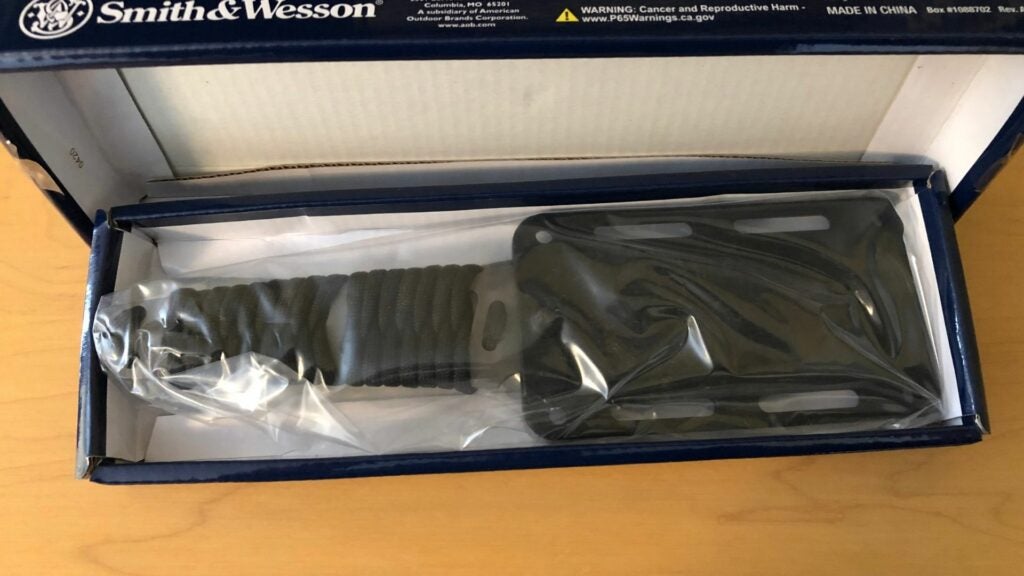 The Smith & Wesson SW910TA (Brian Smyth)
The Smith & Wesson SW910TA (Brian Smyth)
Once I removed the knife and sheath from their transparent bivy sack, I got my first good look at the yet unproven Smith & Wesson with its 7Cr17MoV stainless steel construction and its matte gray finish. My initial impression was not good. In general, the knife looked and felt decent. It fit my hand fairly well and had a good amount of heft for such a lightweight, skeletonized design. The skeletonized handle featured a tight paracord warp which added a little extra girth, but the paracord tails were my first disappointment. They measured a good six inches long compared to the knife’s overall 7.9-inch length. In an outdoor context, they seemed likely to be a nuisance, but in a concealed carry context, those cord tails would drive me nuts! To add insult to injury, my knife’s paracord was very poorly cut and finished with four inner strands sticking out more than half an inch from the end of the black cordage.
The sheath was made from “nylon fiber,” a mildly textured black plastic, with a two-position clip, lashing points along the sides, and a drainage hole near the tip of the blade and felt as much like a budget sheath as I’ve ever seen. The sheath was relatively large, roughly the size of an iPhone 4, but only an eighth to a quarter of an inch thick, nice and slim. Upon removing the knife from the sheath, I was both happy and disappointed. The 3.4-inch blade looked good, but the jimping on the spine of the blade provided no real grip for my thumb. The blade’s retention system also left me feeling disenchanted, as it consisted of a stubby screw through the blade and a divot on the inside of the sheath to secure the knife in place. Not exactly a confidence-inspiring setup. On a more positive note, though, the friction between the knife and sheath was significant, and it was lightweight for its size, weighing in at 3.4 ounces sans sheath and roughly double that when clad.
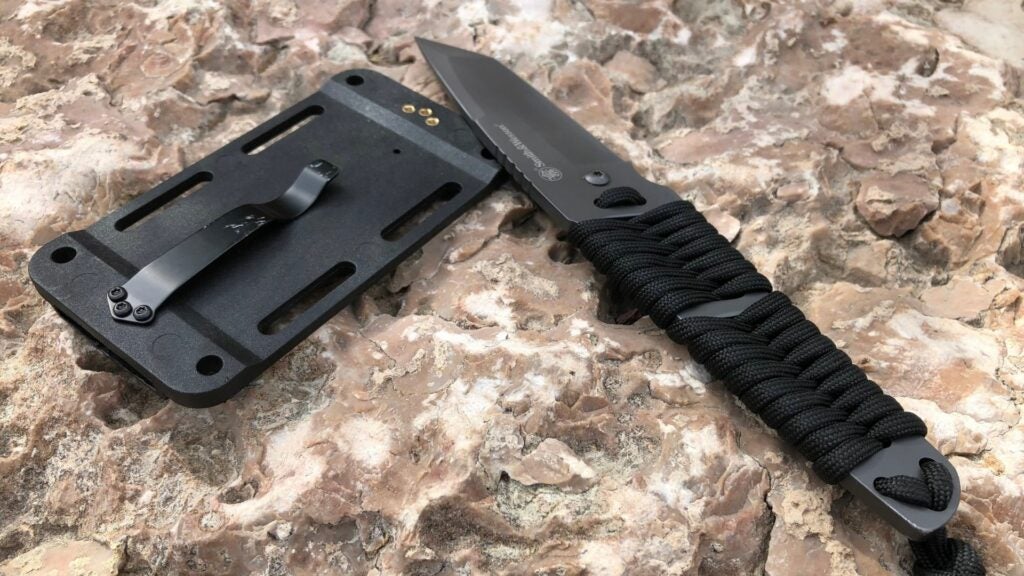 The Smith & Wesson SW910TA (Brian Smyth) How we tested the Smith & Wesson SW910TA
The Smith & Wesson SW910TA (Brian Smyth) How we tested the Smith & Wesson SW910TA
As with any knife I review, the first test I conduct is a traditional paper test. For my testing, I cut a standard piece of printer paper using a light, pulling stroke, and I rely on the blade’s weight to help finish the cut. In terms of factory sharpness, the SW910TA failed with only a half-inch cut compared to a 1.25-inch cut from my Buck 110 with its (roughly) factory sharpness. I conduct both cuts at the same time in order to maintain a consistent stroke and level of pressure. Apples to apples.
Since this Smith & Wesson knife features a fixed blade, I subjected it to both slicing and chopping tests to see how it held up, but before I could do any sort of testing, I knew I had to sharpen the darn thing. So, after roughly 20 strokes on my Smith’s DRET, the edge reached a level on par with a Buck knife straight from the factory. Good enough to start slicing and chopping.
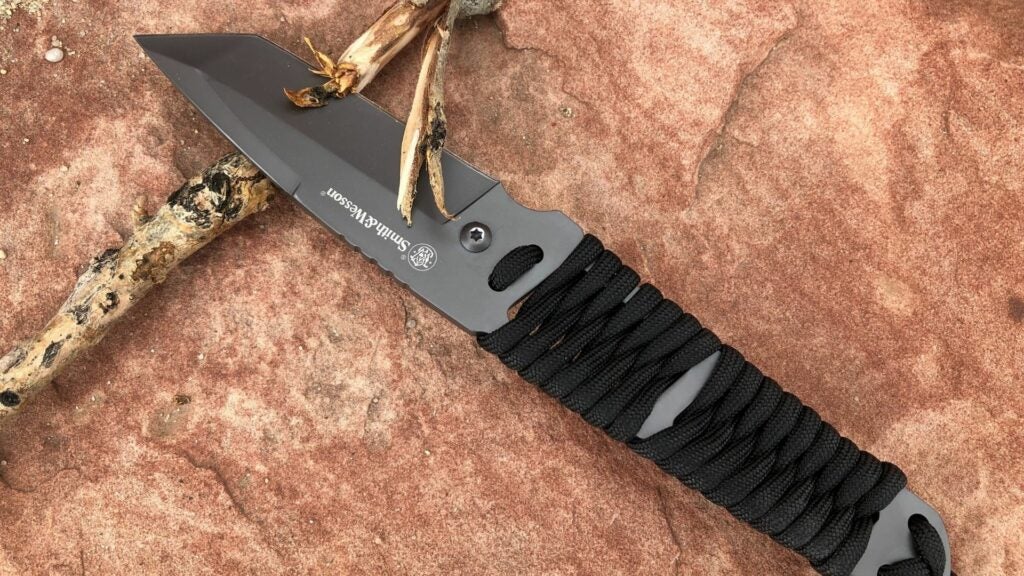 The Smith & Wesson SW910TA (Brian Smyth)
The Smith & Wesson SW910TA (Brian Smyth)
I farmed the first test out to my sister, an avid cook who knows her way around a knife outside of the kitchen as well as in it. (She has her own collection of folding and fixed blade knives.) After she sliced some vegetables for a meal, she informed me that she was happy with it but not blown away by its performance. She noted that in a backcountry cooking scenario on a flat surface, it worked relatively well for food prep, surprising feedback considering the tanto blade shape, and she appreciated the ergonomics, enhanced by the paracord handle. She noted that the angle on the edge made for a nice pivot point while cutting, a nice perk for a knife that clearly wasn’t intended for cooking. She also gave me her full rundown on the knife, but more on that later.
Due to the SW910TA’s obvious outdoorsy design, I figured I’d see how it did with some dry hardwood. I ran the blade over my DRET a handful of times to achieve maximum sharpness, and then started small, whittling away at a small hardwood stick from a nearby apple tree. I immediately noticed that the blade required a good bit of effort compared to my Buck 110 and the Buck 371 I recently tested on a stick from the same tree. Sure, apple wood is hard, but I was expecting noticeably better performance than I got.
Next, I grabbed another hardwood stick from an unknown species from a nearby park. It measured 1.5 to 2 inches across, and I started hacking away. First, I tried hacking at it, replicating the strikes of a hatchet or axe but with a slight sweeping or pulling motion. Almost immediately, I could tell the SW910TA lacked the weight to really bite into the wood, and the handle’s thin profile bit into my hand a bit despite the paracord wrapping.
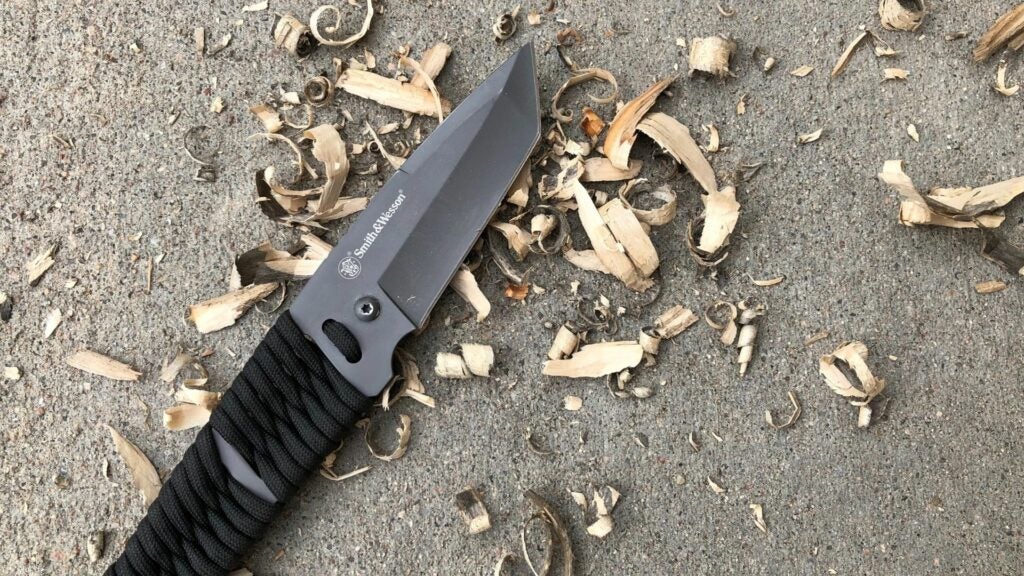 The Smith & Wesson SW910TA (Brian Smyth)
The Smith & Wesson SW910TA (Brian Smyth)
I switched to creating wood shavings, first with one hand and then with two. The knife did well enough, although I still experienced more resistance than I did with Buck’s offerings. The knife was not conducive to two-handed use, since the narrowing spine on the blade only provides enough comfortable real estate for a single thumb. So, I switched to batoning, using a similar-sized stick as my weapon of choice. While I did make progress, I almost felt as if I had been more efficient when I hacked away by hand. That said, I certainly felt no concern with the blade’s ability to take the blows.
With any knife, the ability to take an edge is very important, but for one made of low-end steel, like the SW910TA’s 7Cr17MoV stainless, this ability can make or break a knife. Despite being a soft steel or maybe because of it, this knife seemed to take forever to take an edge or, at least, much longer than I would expect. I guess when you put a budget blade through a battery of moderately difficult tasks, you shouldn’t be surprised when it starts turning into a glorified butter knife.
Lastly, I threw the knife in its sheath up 10 to 20 feet in the air over and over again to see how it would survive impact. I went easy on the first few throws, allowing the entire package to land with a thud in my yard following a 15- to 20-foot arc. Once I was satisfied that the sheath wouldn’t break into a million pieces upon impact, I launched the full combo about 10 feet with my concrete porch serving as the landing pad. Still satisfied, I pushed the envelope with 15-feet maximum altitude to see if the sheath would shatter as I originally expected. Somewhat surprisingly, the sheath came away with only a few minor scrapes and gashes, although one impact did shove the knife deep into the sheath, making the blade quite a challenge to remove.
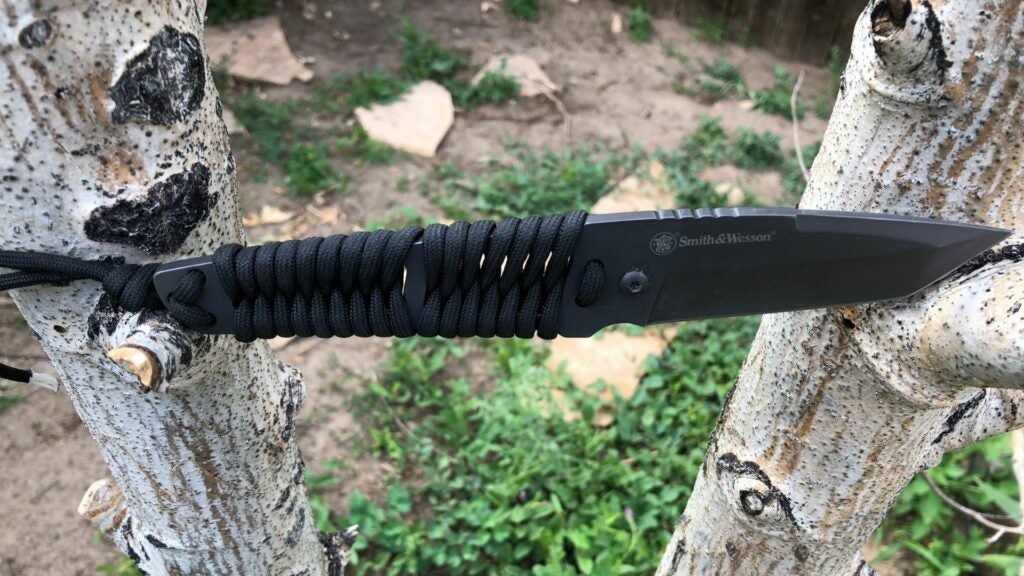 The Smith & Wesson SW910TA (Brian Smyth) What we like about the Smith & Wesson SW910TA
The Smith & Wesson SW910TA (Brian Smyth) What we like about the Smith & Wesson SW910TA
Smith & Wesson may not have the best reputation as a knifemaker, but the SW910TA still has a few bright spots worth noting. Most obviously, this knife is lightweight, although admittedly, this advantage can be a double-edged sword during wood processing chores. It also boasts a sturdy design, thanks in part to the tanto blade pattern, and the whole package took a decent pounding with little issue, courtesy of Old Man Gravity.
The SW910TA has good ergonomics, especially for smaller hands, and the paracord wrap provides a decently good in-hand feel despite the thin profile. The blade itself was fairly easy to sharpen, and the sheath includes multiple lashing points to easily attach it to a boot, a backpack, or another piece of gear. The sheath also provided quite a strong friction grip on the blade, eliminating any concerns about losing the knife during the break-in period.
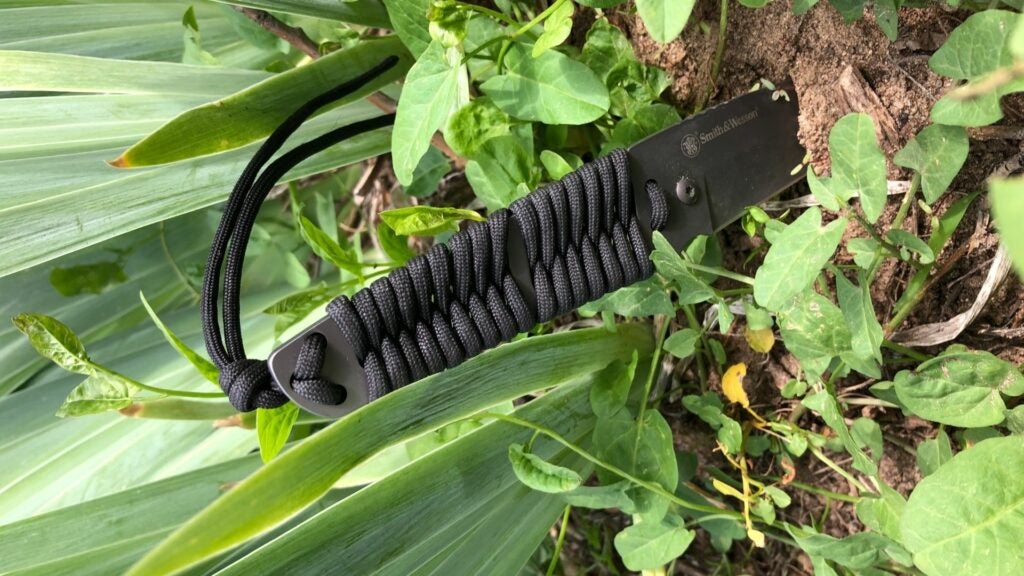 The Smith & Wesson SW910TA (Brian Smyth) What we don’t like about the Smith & Wesson SW910TA
The Smith & Wesson SW910TA (Brian Smyth) What we don’t like about the Smith & Wesson SW910TA
While the SW910TA does have a few bright spots, it has more than enough tarnish to go around. Most obviously, Smith & Wesson’s quality assurance in the knife department was very disappointing, and both the factory sharpness and the use of a screw as part of the retention system as opposed to a more secure option undermined my confidence in this blade. The jimping on the blade’s spine provides limited grip, and the long paracord tails provide little aesthetic and no practical value. (The tails could even be a liability near a campfire.) The blade’s edge life is terrible, thanks to the use of low-grade 7Cr17MoV steel.
Unfortunately, the sheath is equally disappointing. Its nylon construction provides plenty of friction when new, but I have my doubts as to whether or not the material will keep its form after months of frequent use. In fact, the friction fit is so strong that it easily overcame the relatively weak clip on the sheath. While you certainly won’t lose your knife during the break-in period, you also won’t be able to draw it single-handedly without lashing it down good and tight first. The clip can be positioned for two different carry orientations, but if your clip won’t hold onto your belt or bag, what good is it?
Verdict
The jury has examined the evidence and found the Smith & Wesson SW910TA guilty on almost every count. Honestly, I really wanted this knife to succeed to prove the haters wrong, but in the end, it let me down, coming up short in almost every meaningful category and damning itself in the process. Is it entirely worthless? I wouldn’t go that far, but I’d come close.
Instead, I’ll let my sister do the talking. During her assessment of the knife, she said the SW910TA looked like a “teenager’s knife,” something an acne-faced 16-year-old might buy after receiving his first real paycheck: It bears the Smith & Wesson name and looks cool but does little else. She had a slightly more charitable evaluation of the knife than I did; however, she put it through milder testing than I did. Still, she was only slightly happy with it, and she was not comfortable relying on it in more stressful situations.
I really had hoped the SW910TA would breathe some life into Smith & Wesson’s knife-making reputation, but unfortunately, I’ll have to keep looking for a blade that can do that job. Then again, maybe I should leave that hunt to someone else.
FAQs about the Smith & Wesson SW910TA
More questions? Here’s Task & Purpose’s additional brief.
Q. How much does the Smith & Wesson SW910TA cost?
A. Smith & Wesson lists the MSRP for the SW910TA at $32.99, but many third party retailers are pricing it right around $20 instead.
Q. Is 7Cr17MoV steel good?
A. As far as blade steels go, 7Cr17MoV stainless steel tends to be very inexpensive, but that comes at the cost of hardness. As such, 7Cr17MoV tends to be soft, dents easily, and it dulls quickly, even during mild use. That said, it does take an edge fairly easily and it is quite resistant to corrosion.
Q. Why does the Smith & Wesson SW910TA have paracord on the handle?
A. Usually, knives with paracord are aimed at buyers interested in outdoor adventures or worst-case scenarios. A good survivalist understands the value of keeping some 550 cord on hand, but more often than not, knife manufacturers use “paracord” handles more as a marketing ploy than a practical solution to real-world problems as their cord of choice tends to be weaker than 550 cord and shorter than many would find practical.
We’re here to be expert operators in everything How-To related. Use us, compliment us, tell us we’ve gone full FUBAR. Comment below and let’s talk! You can also shout at us on Twitter or Instagram.
For over 25 years, Brian Smyth has been neighbors with the Air Force Academy and the U.S. Army’s Ivy Division. He loves the challenge of crafting words and has written for The Drive, Car Bibles, and other publications. Nothing gets him going quite like the roar of dual Pratt & Whitneys overhead, the smell of cordite, and the stories of the Greatest Generation.
Task & Purpose and its partners may earn a commission if you purchase a product through one of our links. Learn more about our product review process.